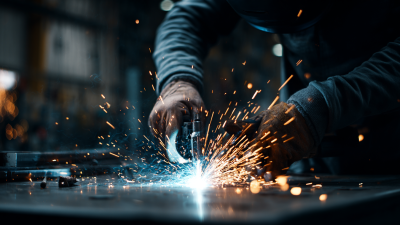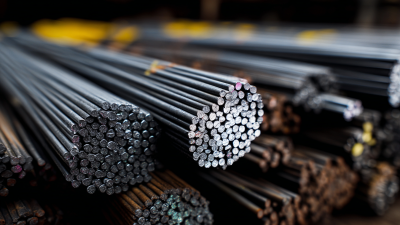Mastering Flux Core Welding Techniques for Beginners and Pros Alike
Table of Contents
- Understanding the Basics of Flux Core Welding: A Beginner's Guide
- Essential Equipment and Setup for Flux Core Welding Success
- Common Techniques to Enhance Your Flux Core Welding Skills
- Troubleshooting Common Flux Core Welding Issues
- Advanced Tips for Experienced Welders to Perfect Their Craft
- FAQS
- Conclusion
- Related Posts
You know, Flux Core Welding is a pretty important skill in the welding world. It’s super versatile and efficient, so whether you’re just starting out or you’re a seasoned pro, it’s something worth mastering. Wenzhou Tianyu Electronic Co., Ltd. has been around since 2000—over 22 years now—and they really know their stuff when it comes to making top-notch welding electrodes and consumables. They've got a pretty wide selection, including stainless steel, carbon steel, and low alloy electrodes, so whatever kind of welding you’re into, they’ve got you covered. As I’ve been learning more about Flux Core Welding, I really hope to help other welders get the hang of it—share some tips and tricks so they can get better results in their projects. With solid techniques and good quality materials from Wenzhou Tianyu, welders can feel more confident tackling all kinds of challenges and really step up their game.

Understanding the Basics of Flux Core Welding: A Beginner's Guide
Flux core welding is honestly a pretty important technique in the metalworking world. Whether you're just starting out or are a seasoned pro looking to polish up your skills, this method comes in handy. Basically, it uses a tubular wire filled with flux that shields the weld from contamination as it cools and hardens. One of the best parts? It’s super versatile—great for working on different kinds of metals and perfect for outdoor jobs where wind could mess with other types of welding. Yep, it’s pretty handy in a bunch of situations.
Getting the hang of flux core welding means you’ve gotta understand your equipment and techniques. Most setups use a constant voltage power supply, and if you're new, just focus on tweaking the wire feed speed and voltage to suit the material you're working with. Also, paying attention to your torch angle and how fast you’re moving along the weld line makes a big difference in how it turns out. Companies like Wenzhou Tianyu Electronic Co., Ltd. really help out here—they supply high-quality welding electrodes and consumables that are perfect for both newcomers and seasoned welders. They've been around since 2000, and over the years, they’ve built a solid reputation for offering products that help everyone get the job done right and look good too.
Mastering Flux Core Welding Techniques for Beginners and Pros Alike
| Technique | Description | Skill Level | Common Applications |
|---|---|---|---|
| Plug Welding | A technique where welds are made through holes in one material to connect with another. | Beginner | Fabrication of sheet metal parts. |
| Stringer Bead | A continuous weld made in a straight line, usually with minimal pause. | Intermediate | Structural applications, such as framing. |
| Weave Pattern | A zigzag or circular motion during welding to create wider welds. | Advanced | Heavy-duty applications, like vehicle chassis. |
| Tack Welding | Short welds used to hold components in place before final welding. | Beginner | Assembly work and positioning. |
| Overhead Welding | Welding done in an inverted position, requires different techniques. | Expert | Construction, maintenance work. |
Essential Equipment and Setup for Flux Core Welding Success
If you're aiming to get good at flux core welding, one of the most important things is picking the right gear and setting up your workspace properly. For those just starting out, don’t worry—there are plenty of affordable options that perform well without costing a fortune. Small, lightweight machines are especially great if you’re planning to do some work at home; you can even get started with something for under $200. These beginner-friendly welders usually come with easy-to-use features, so it’s less intimidating for newbies to pick up the basics of flux core welding.
On the other hand, if you want to level up your skills, there are more advanced machines that can handle different welding processes. That kind of versatility is pretty handy—you’ll be able to work on all kinds of projects, from quick repairs to more involved builds. Plus, recent tech improvements mean you’ll get higher precision and faster results, which is a big plus whether you’re just starting out or already experienced. Making sure you choose the right equipment and set everything up properly can really make a difference in your work quality, setting you up for success in any welding project you take on.
Common Techniques to Enhance Your Flux Core Welding Skills
 Flux core welding is pretty versatile and efficient — it’s a go-to for both newbies and seasoned pros alike. If you're looking to level up your skills, learning a few key techniques can make a real difference in how your welds turn out. For starters, getting the hang of maintaining the right travel speed is a game-changer. Moving too quickly can leave you with weaker joints, while going too slow might cause excess buildup of weld material. It’s all about finding that sweet spot where your bead is steady, penetrates well, and you don’t get a ton of spatter.
Flux core welding is pretty versatile and efficient — it’s a go-to for both newbies and seasoned pros alike. If you're looking to level up your skills, learning a few key techniques can make a real difference in how your welds turn out. For starters, getting the hang of maintaining the right travel speed is a game-changer. Moving too quickly can leave you with weaker joints, while going too slow might cause excess buildup of weld material. It’s all about finding that sweet spot where your bead is steady, penetrates well, and you don’t get a ton of spatter.
Another thing that’s super helpful is adjusting your wire feed speed properly. The rate at which the wire feeds needs to match the thickness of the metal you're working with. If it’s too slow, you risk burning through the material, but if it’s too fast, your weld might not penetrate enough. Also, playing around with your welding angle can make a big difference. For example, a slight push tilt — leaning the gun forward just a bit — can give you a flatter weld, which is often preferred for horizontal or overhead work. Honestly, messing around with these techniques and finding what works best for you can really boost your welding game. Your welds will come out cleaner and look way more professional — I promise, it’s worth the effort.
Troubleshooting Common Flux Core Welding Issues
When you're working with Flux Core Welding, it's pretty normal to run into some common issues—whether you're just starting out or you've been at it for a while. One of the most frequent problems is inconsistent wire feeding, which can mess up your welds and make things frustrating. That usually happens because of a blockage in your gun or if the tension isn't set quite right. _Pro tip:_ take a sec to check your wire spool—the bends or any obstructions—and make sure the tension isn't too tight or too loose. It should feed smoothly, with just enough resistance.
Another headache welders often complain about is a poor arc strike. It can be really annoying when you're in the middle of a project. Usually, this happens if the polarity settings are off or if the work surface is dirty. _Here's a quick tip:_ keep your workspace clean—no rust, paint, or grease—and double-check that your machine’s polarity matches the type of flux core wire you're using.
And then there's all that spatter. If you notice a ton of messy welds, it’s probably a sign that your voltage or wire speed is off. Too high a voltage or an incorrect feed rate can create more splatter than you want. _My advice:_ start with the settings recommended by the manufacturer, and then tweak them a little bit at a time, watching how it affects your weld. It’s all about finding that sweet spot for the best results.

Advanced Tips for Experienced Welders to Perfect Their Craft
If you're a seasoned welder looking to step up your flux core welding game, learning some advanced techniques can really make a difference in the quality and speed of your work. For starters, getting a good handle on how to tweak the voltage and wire feed speed is crucial. Adjusting these carefully—especially based on the metal’s thickness and type—can help you create cleaner arcs and smoother beads, which means less fixing up afterward.
Also, don’t be afraid to play around with different torch angles. Changing your position a bit can improve weld penetration and give you better control over the weld pool. Experimenting with different angles is worth it because it affects heat distribution and can lead to stronger, more reliable joints. Plus, techniques like weaving or moving the torch in circular motions can really boost fusion and overall weld strength.
If you keep practicing these tips and stay curious, you'll find yourself perfecting your flux core welding and delivering consistently awesome results. It’s all about trial, error, and a little patience, but the improvements are totally worth it!
FAQS
: Maintaining the right travel speed is essential because traveling too fast can lead to weak joints, while moving too slowly can cause excessive buildup of weld material. The goal is to find a balance that ensures a consistent bead with good penetration and minimal spatter.
The wire feed speed must match the thickness of the material being welded; too slow can lead to burn-through, while too fast can result in inadequate penetration. Proper adjustment is crucial for optimal welding results.
Manipulating the welding angle, such as using a slight push technique where the gun is tilted forward, can produce a flatter weld. Experimenting with different angles can help achieve better results, especially in horizontal or overhead applications.
Inconsistent wire feeding can be caused by blockages in the gun or incorrect tension settings. Regular checks for bends or obstructions in the wire spool and adjusting the tension can help ensure smooth feeding.
Ensuring a proper arc strike involves making sure the work surface is clean of rust, paint, or grease and verifying that the machine is set to the correct polarity for the type of flux core wire used.
Excessive spatter often indicates that the voltage or wire speed settings are incorrectly set. It is advisable to start with the manufacturer's recommendations and adjust gradually to achieve optimal weld quality.
Advanced welders should focus on fine-tuning voltage and wire feed speed based on metal thickness and type, experimenting with different torch angles for better penetration, and incorporating techniques like weaving or circular motion for improved fusion and strength in welds.
Meticulously adjusting voltage and wire feed speed can lead to cleaner arcs and better bead profiles, which reduces the need for post-weld cleanup and enhances the overall quality of the weld.
Conclusion
So, I came across this article titled "Mastering Flux Core Welding Techniques for Beginners and Pros Alike," and honestly, it’s pretty much a goldmine whether you're just starting out or you've been at it for a while. It kicks off by breaking down the basics of Flux Core Welding in a way that’s easy to grasp—so don’t worry if you’re new to this stuff. Then, it dives into the essential tools and setup, making sure you’re all set for a smooth welding experience. They also cover common techniques to help sharpen your skills and include handy troubleshooting tips for those pesky challenges that pop up sometimes.
But here’s the cool part: the article doesn’t stop there. It also shares some advanced tips for the seasoned welders out there who want to take their craft to the next level. Overall, it’s a super useful resource for anyone who’s serious about improving their Flux Core Welding game.
And just a quick shoutout—Wenzhou Tianyu Electronic Co., Ltd., with over 22 years in the industry producing welding electrodes and consumables, really gets how important it is to master these techniques. After all, good technique means better welds and longer-lasting results in whatever projects you’re working on.
Related Posts
-

Exploring Alternative Solutions to Flux Core Welding for Global Buyers
-

Mastering Flux Core Welding Techniques for Perfect Joints Every Time
-

Solutions for Enhancing Welding Quality with 6010 Welding Rod
-

Unlocking Advantages of Solder Alloys for Enhanced Performance in Electronics
-

Ultimate Checklist to Choose the Best Tig Wire for Your Welding Projects
-

Mastering Global Trade Compliance for Best 6011 Welding Rods with Essential Certification Insights
Blog Tags:

